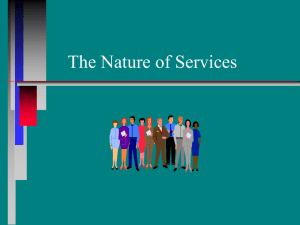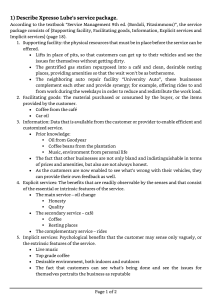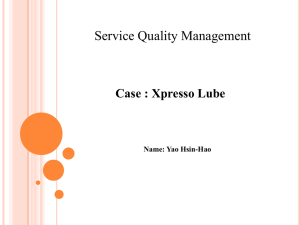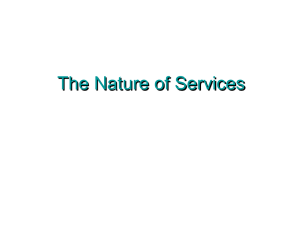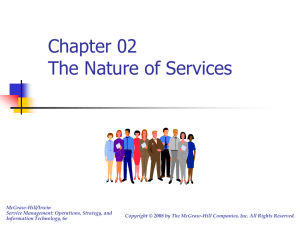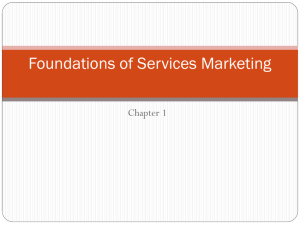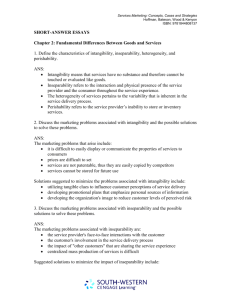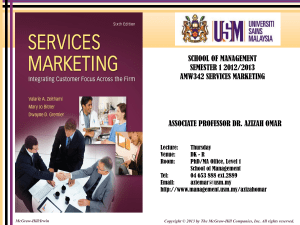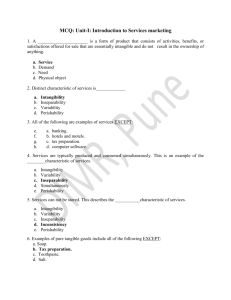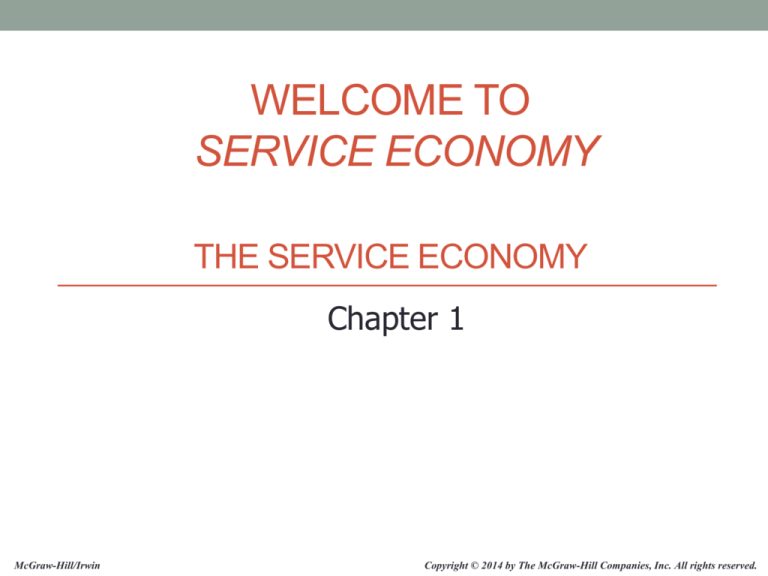
WELCOME TO
SERVICE ECONOMY
THE SERVICE ECONOMY
Chapter 1
McGraw-Hill/Irwin
Copyright © 2014 by The McGraw-Hill Companies, Inc. All rights reserved.
Learning Objectives
• Describe the central role of services in an economy.
• Identify and differentiate the five stages of economic activity.
• Describe the features of preindustrial, industrial, and
•
•
•
•
•
postindustrial societies.
Describe the features of the experience economy contrasting
the consumer (B2C) with the business (B2B).
Explain the essential features of the service-dominant logic.
Identify and critique the six distinctive characteristics of a
service operation and explain the implications for managers.
Describe a service using the service package dimensions.
Use the service process matrix to classify a service.
1-2
Service Definitions
Services are deeds, processes, and
performances.
Valarie Zeithaml & Mary Jo Bitner
A service is a time-perishable, intangible
experience performed for a customer acting in
the role of a co-producer.
James Fitzsimmons
1-3
Definition of Service Firms
Service enterprises are organizations that facilitate the
production and distribution of goods, support other firms
in meeting their goals, and add value to our personal
lives.
James Fitzsimmons
1-4
Percent Employment in Services
Nation
China
India
USA
Indonesia
Brazil
Russia
Japan
Nigeria
Banglades
h
Germany
% of World
Labor
21.0
% Ag
% Goods % Services
2.2
2.2
50
60
2
45
23
12
5
70
63
15
17
20
16
24
23
26
10
11
35
23
78
39
53
65
69
20
26
1.4
3
28
69
17.0
4.8
3.9
3.0
2.5
2.4
1-5
Role of Services in an Economy
FINANCIAL SERVICES
· Financing
· Leasing
· Insurance
MANUFACTURING
Services inside company:
· Finance
· Accounting
· Legal
· R&D and design
BUSINESS SERVICES
· Consulting
· Auditing
· Advertising
· Waste disposal
INFRASTRUCTURE SERVICE
· Communications
· Transportation
· Utilities
· Banking
DISTRIBUTION
SERVICES
· Wholesaling
· Retailing
· Repairing
PERSONAL SERVICES
· Healthcare
· Restaurants
· Hotels
CONSUMER
(Self-service)
GOVERNMENT SERVICES
· Military
· Education
· Judicial
· Police and fire protection
1-6
Stages of Economic Activity
Quinary (Extending Human Potential):
Health, Education, Research, Arts, Recreation
Quaternary (Trade and Commerce):
Transportation, Communications, Retailing, Finance, Government
Tertiary (Domestic Services): Restaurants, Hotels, Laundry, Maintenance
Secondary (Goods-Producing): Manufacturing, Processing
Primary (Extractive): Agriculture, Mining, Fishing, Forestry
1-7
Trends in U.S. Employment by Sector
Percent
Services:
Value from enhancing the
capabilities and interactions
among people
Goods:
Value from
making a product
Agriculture:
Value from
harvesting nature
Year
2012
1-8
Stages of Economic Development
Society
Game
PreAgainst
Industrial Nature
Industrial
Postindustrial
Predominant
Activity
Agriculture
Mining
Use of
Human
Labor
Raw
Extended
muscle
household
power
Against
Goods
Machine
fabricated production tending
nature
Among Services
Persons
Standard
Unit of
of Living
Social Life Measure Structure
Artistic
Creative
Intellectual
Individual
Technology
SubRoutine
Simple hand
sistence Traditional
tools
Authoritative
Quantity
of goods
Community Quality of
life in terms
health,
education,
recreation
Bureaucratic Machines
Hierarchical
Interdependent
Information
1-9
Distribution of U.S. Employment, 2009
Agriculture and mining
2%
Construction
Retail and
wholesale trade
14%
5%
Manufacturing
9%
Federal government 2%
Professional and
business services
12%
Information 2%
Transportation and utilities 19%
Other services 4%
Health care
and social assistance
11%
Educational services
2%
Leisure and hospitality
9%
State and local government
13%
Self employed and
Financial services unpaid family workers
6%
6%
1-10
Projected U.S. Job Growth, 2008 – 2018
1-11
Economic Evolution
Economy
Agrarian
Industrial
Service
Experience
Economic
Offering
Food
Packaged
goods
Commodity
service
Consumer
services
Business
services
Function
Extract
Make
Deliver
Stage
Co-create
Nature
Fungible
Tangible
Intangible
Memorable
Effectual
Attribute
Natural
Standardized
Customized
Personal
Growth
Method of
Supply
Stored in
bulk
Inventoried
Delivered on
demand
Revealed over
time
Sustained over
time
Seller
Trader
Producer
Provider
Stager
Collaborator
Buyer
Market
Customer
Client
Guest
Collaborator
Expectation
Quantity
Features
Benefits
Sensations
Capability
1-12
The Four Realms of an Experience
Customer Participation
Passive
Active
Absorption Entertainment Education
(Movie)
(Language)
Environmental
Relationship
Immersion Esthetic
(Tourist)
Escapist
(ScubaDiving)
1-13
Experience Design Principles
• Theme the Experience (Forum shops)
• Harmonize Impressions with Positive Cues
(O’Hare airport parking garage)
• Eliminate Negative Cues
(Cinemark talking trash containers)
• Mix in Memorabilia (Hard Rock T-shirts)
• Engage all Five Senses (Mist in Rainforest)
1-14
Typology of Services in the 21st Century
Core Experience
Essential Feature
Examples
Creative
Present ideas
Advertising, theater
Enabling
Act as intermediary
Transportation, communications
Experiential
Presence of customer
Massage, theme park
Extending
Extend and maintain
Warranty, health check
Entrusted
Contractual agreement
Service/repair, portfolio mgt.
Information
Access to information
Internet search engine
Innovation
Facilitate new concepts
R&D services, product testing
Problem solving
Access to specialists
Consultants, counseling
Quality of life
Improve well-being
Healthcare, recreation, tourism
Regulation
Establish rules and regulations
Environment, legal, patents
1-15
Foundation Premises of ServiceDominant Logic
1. Service is the fundamental basis of exchange.
2. Indirect exchange masks the basis of exchange.
3. Goods are distribution mechanisms for service provision.
4. Operant resources are the source of competitive advantage
5. All economies are service economies.
6. The customer is always a co-creator of value.
7. The enterprise can only offer value propositions.
8. A service-centered view is customer oriented and relational.
9. All economic and social actors are resource integrators.
10. Value is uniquely determined by the beneficiary.
1-16
Distinctive Characteristics of Services
• Simultaneity: opportunities for personal selling,
•
•
•
•
interaction creates customer perceptions of quality
Perishability: cannot inventory, opportunity loss of idle
capacity, need to match supply with demand
Intangibility: creative advertising, no patent protection,
importance of reputation
Heterogeneity: customer involvement in delivery process
results in variability
Customer Participation in the Service Process:
attention to facility design, opportunities for co-production,
concern for customer and employee behavior
1-17
Non-ownership Classification of
Services
Type of Service
Customer value
Examples
Management Challenge
Goods rental
Obtain temporary right to
exclusive use
Vehicles, tools, furniture,
equipment
Site selection and
maintenance
Place and space
rental
Obtain exclusive use of
defined portion of a
larger space
Hotel room, seat on
airplane, storage unit
Housekeeping and
achieving economies
of scale
Labor and
expertise
Hire other people to do a
job
Car repair, surgery,
management
consulting
Expertise is a renewable
resource, but time is
perishable
Physical facility
usage
Gain admission to a
facility for a period of
time
Theme park, camp
ground, physical
fitness gym
Queuing and crowd control
Network usage
Gain access to participate
Electric utility, cell phone,
internet
Availability and pricing
decisions
1-18
Implications of Rental/Usage
Paradigm
• Creates the option of renting a good upon demand
rather than purchase.
• Service often involves selling slices of larger physical
entities.
• Labor and expertise are renewable resources.
• Time plays a central role in most services.
• Service pricing should vary with time and availability.
Question: Can services in general be described as
customers sharing resources?
1-19
Service Package
1-20
The Service Package
• Supporting Facility: The physical resources that must
be in place before a service can be sold. Examples are
golf course, ski lift, hospital, airplane.
• Facilitating Goods: The material consumed by the buyer
or items provided by the consumer. Examples are food
items, legal documents, golf clubs, medical history.
• Information: Operations data or information that is
provided by the customer to enable efficient and
customized service. Examples are patient medical
records, seats available on a flight, customer preferences,
location of customer to dispatch a taxi.
1-21
The Service Package (cont.)
• Explicit Services: Benefits readily observable by the
senses. The essential or intrinsic features. Examples are
quality of meal, attitude of the waiter, on-time departure.
• Implicit Services: Psychological benefits or extrinsic
features which the consumer may sense only vaguely.
Examples are privacy of loan office, security of a well
lighted parking lot.
1-22
The Service Process Matrix
Degree
of labor Intensity
Low
High
Degree of Interaction and Customization
Low
High
Service Factory
Service Shop
* Airlines
* Hospitals
* Trucking
* Auto repair
* Hotels
* Other repair services
* Resorts and recreation
Mass Service
* Retailing
* Wholesaling
* Schools
* Retail banking
Professional Service
* Doctors
* Lawyers
* Accountants
* Architects
1-23
Open Systems View of Services
1-24
Village Volvo’s Service Package
• Supporting Facility
• Facilitating Goods
• Information
• Explicit Services
• Implicit Services
1-25
Village Volvo’s Distinctive Service
Characteristics
• Intangibility
• Perishability
• Heterogeneity
• Simultaneity
• Customer Participation in the Service Process
1-26
Managing Village Volvo
• How could Village Volvo manage its back office (repair
operations) like a factory?
• How can Village Volvo differentiate itself from Volvo
dealers?
1-27
Xpresso Lube Facility
1-28
Xpresso Lube’s Service Package
• Supporting Facility
• Facilitating Goods
• Information
• Explicit Services
• Implicit Services
1-29
Xpresso Lube’s Distinctive Service
Characteristics
• Intangibility
• Perishability
• Heterogeneity
• Simultaneity
• Customer Participation in the Service Process
1-30
Beyond Xpresso Lube
• What elements of Xpresso Lube’s location contribute to its
success?
• Given the example of Xpresso Lube, what other services
could be combined to “add value” for the customer?
1-31
Discussion Topics
• Illustrate how the type of work he or she does influences a person’s
•
•
•
•
•
lifestyle. For example, contrast a farmer, a factory worker, and a school
teacher.
Is it possible for an economy to be based entirely on services?
What is the value of self-service in an economy?
Determine if the service sector is currently expanding or contracting
based upon the Non-Manufacturing Index (NMI) found at the ISM Report
on Business on the Institute of Supply Management website:
www.ism.ws/ismreport/
What are some management problems associated with allowing service
employees to exercise judgment in meeting customer needs?
Critique the “Distinctive Characteristics of Service Operations” by
arguing that the characteristics of customer participation, simultaneity,
perishability, intangibility, and heterogeneity may apply to goods as well.
1-32
Interactive Class Exercise
The class breaks into small groups. Each group identifies
service firms that should be listed in the Fortune 100 and
places them in rank order of estimated annual revenue.
http://money.cnn.com/magazines/fortune/fortune500/2012/f
ull_list/
1-33

